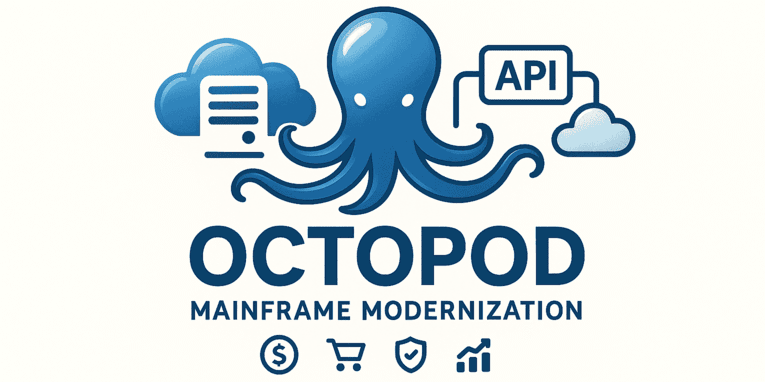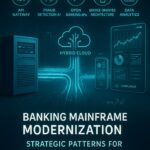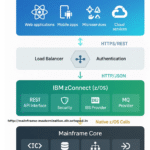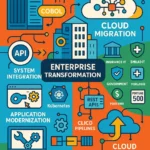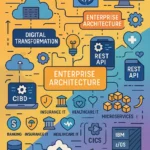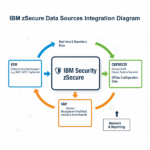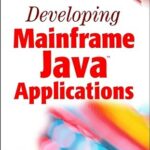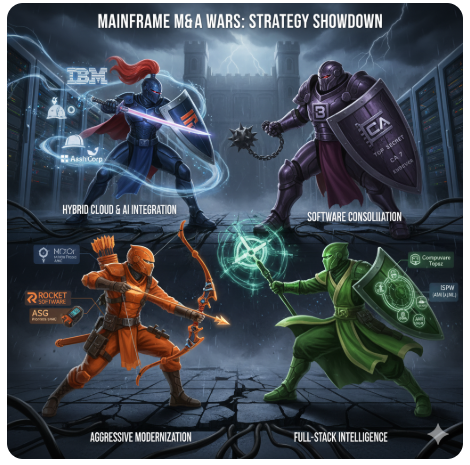TL;DR
The mainframe modernization market will grow from $8.39B (2025) to $13.34B (2030) at 9.7% CAGR. Organizations must modernize now due to retiring expertise, cloud imperatives, and digital transformation demands while maintaining business continuity.
Market Opportunity & Size
Current Market Value (2025)
- Total Market: $8.39 billion USD
- Modernization Services: $2.66 billion USD
- Projected 2030: $13.34 billion USD
- Growth Rate: 9.7% CAGR (2025-2030)
10-20 Year Outlook (2025-2045)
Based on current growth trajectories and market drivers:
- 2030: $13.34 billion USD (confirmed projections)
- 2035: $20-25 billion USD (estimated based on sustained 8-10% CAGR)
- 2040: $30-40 billion USD (projected with market maturation)
- 2045: $45-60 billion USD (long-term extrapolation)
Note: Long-term projections assume continued digital transformation, cloud adoption, and emerging technology integration
What: The Modernization Imperative
Core Challenge
Organizations operate critical business systems on mainframes built 20-50 years ago. These legacy systems:
- Handle 70% of global financial transactions
- Process $3+ trillion in daily payments
- Support core operations in banking, insurance, government, and healthcare
- Face imminent skills crisis as experts retire
Modernization Scope
- Application Modernization: Converting COBOL/legacy code to modern languages
- Infrastructure Migration: Moving to cloud/hybrid architectures
- Data Modernization: Enabling real-time analytics and AI integration
- Interface Modernization: Creating modern APIs and user experiences
Why: Business Drivers & Urgency
Critical Risk Factors
- Skills Crisis: 60% of mainframe experts are over 50 years old
- Technical Debt: Maintenance costs increasing 15-20% annually
- Competitive Disadvantage: Inability to deploy modern digital services rapidly
- Regulatory Compliance: Difficulty meeting evolving data protection requirements
Strategic Opportunities
- Cost Optimization: 20-40% reduction in operational expenses
- Agility Enhancement: 10x faster deployment of new services
- Innovation Enablement: AI/ML integration, real-time analytics
- Risk Mitigation: Reduced single points of failure
Market Forces
- Digital Transformation: Customer expectations for digital-first experiences
- Cloud Adoption: 85% of enterprises adopting hybrid cloud strategies
- Regulatory Pressure: Data sovereignty and real-time reporting requirements
- Competitive Pressure: Fintech and digital natives disrupting traditional industries
How: Strategic Approach & Implementation
Modernization Strategies
1. Rehost (Lift & Shift)
- Timeline: 6-12 months
- Cost: Lowest initial investment
- Risk: Low technical risk
- Benefit: Immediate infrastructure cost savings (20-30%)
2. Replatform (Lift, Tinker & Shift)
- Timeline: 12-24 months
- Cost: Moderate investment
- Risk: Medium technical risk
- Benefit: Performance improvements + cloud benefits
3. Refactor/Rearchitect
- Timeline: 18-36 months
- Cost: Highest investment
- Risk: Highest technical risk
- Benefit: Maximum agility + innovation capability
4. Hybrid Approach (Recommended)
- Timeline: Phased over 2-5 years
- Cost: Balanced investment
- Risk: Managed through phases
- Benefit: Continuous value delivery + risk mitigation
Implementation Framework
Phase 1: Assessment & Planning (3-6 months)
- Application portfolio analysis
- Technical debt assessment
- Business impact mapping
- ROI modeling
- Skills gap analysis
Phase 2: Foundation Building (6-12 months)
- Cloud infrastructure setup
- DevOps pipeline establishment
- Security framework implementation
- Team training and capability building
Phase 3: Pilot Migration (6-12 months)
- Select low-risk, high-value applications
- Proof of concept development
- Process refinement
- Success metrics validation
Phase 4: Scaled Modernization (12-36 months)
- Core system migration
- Business process optimization
- Advanced analytics integration
- Continuous improvement
Financial Investment & Returns
Investment Requirements
- Small Enterprise ($1B revenue): $5-15M over 3-5 years
- Mid-Market ($10B revenue): $25-75M over 3-5 years
- Large Enterprise ($50B+ revenue): $100-500M over 5-7 years
Expected Returns
- Operational Cost Savings: 20-40% reduction in IT costs
- Development Velocity: 5-10x faster time-to-market
- Revenue Enhancement: 10-25% increase from new digital capabilities
- Risk Reduction: Quantified business continuity improvements
- ROI Timeline: 18-36 months for most initiatives
Regional Market Dynamics
North America (41% market share)
- Drivers: Financial services dominance, regulatory requirements
- Investment Focus: Cloud migration, AI integration
- Timeline: Accelerated due to skills crisis
Asia Pacific (Fastest growth at 9.8% CAGR)
- Drivers: Government digital initiatives, economic growth
- Investment Focus: Infrastructure modernization, sovereign cloud
- Opportunity: Emerging market expansion
Europe (Steady growth)
- Drivers: GDPR compliance, digital sovereignty
- Investment Focus: Hybrid cloud, data residency
- Challenge: Economic headwinds affecting investment timing
Technology Trends & Future Considerations
Emerging Technologies
- AI-Powered Migration Tools: Automated code conversion and testing
- Containerization: Kubernetes for mainframe workloads
- Edge Computing: Distributed processing architectures
- Quantum-Safe Cryptography: Future-proofing security
Vendor Landscape
- Traditional Leaders: IBM, Micro Focus, BMC Software
- Cloud Providers: AWS, Microsoft Azure, Google Cloud
- Specialists: Astadia, Modern Systems, LzLabs
- Emerging Players: AI-powered migration startups
Risk Management & Mitigation
Primary Risks
- Business Continuity: System downtime during migration
- Data Integrity: Information loss or corruption
- Skills Gap: Insufficient expertise for complex migrations
- Vendor Lock-in: Dependency on specific modernization platforms
- Budget Overruns: Scope creep and hidden complexities
Mitigation Strategies
- Phased Approach: Minimize business disruption
- Comprehensive Testing: Automated validation frameworks
- Skills Development: Training programs and external partnerships
- Multi-Vendor Strategy: Avoid single-source dependencies
- Agile Governance: Flexible project management with regular checkpoints
Recommendations for Leadership
Immediate Actions (Next 90 Days)
- Conduct Assessment: Comprehensive mainframe inventory and business impact analysis
- Build Coalition: Establish cross-functional modernization steering committee
- Secure Budget: Develop 3-5 year investment plan with board approval
- Partner Selection: Evaluate and engage modernization partners
Strategic Priorities (6-12 Months)
- Pilot Program: Launch low-risk modernization initiative
- Skills Investment: Begin training programs and recruitment
- Architecture Planning: Design target state architecture
- Governance Framework: Establish project management and risk oversight
Long-term Vision (2-5 Years)
- Systematic Modernization: Execute comprehensive transformation program
- Innovation Platform: Leverage modern architecture for competitive advantage
- Continuous Evolution: Establish ongoing modernization capabilities
- Market Leadership: Position organization as digital transformation leader
Conclusion
Mainframe modernization represents both an urgent necessity and a strategic opportunity. With a rapidly growing market and critical business drivers, organizations must act decisively while managing inherent risks through careful planning and phased execution. The investment is substantial but the cost of inaction—system failures, competitive disadvantage, and operational inefficiencies—far exceeds modernization costs.
The time to act is now. Organizations that begin their modernization journey today will be positioned to capture the benefits of digital transformation while those that delay face increasing risks and costs.
This executive summary is based on comprehensive market research and industry analysis as of August 2025.
References
- GII Research. (2024). Global mainframe market research report by systems. Retrieved from https://www.giiresearch.com/report/marf1709504-global-mainframe-market-research-report-by-systems.html
- MarketsandMarkets. (2024). Mainframe modernization market. Retrieved from https://www.marketsandmarkets.com/Market-Reports/mainframe-modernization-market-52477.html
- IDC. (2024). Research forecasts. Retrieved from https://www.idc.com/research/forecasts.jsp
- Gartner. (2024). Mainframe market insights. Retrieved from https://www.gartner.com/en/documents/5769515
- Mordor Intelligence. (2024). Mainframe market report. Retrieved from https://www.mordorintelligence.com/industry-reports/mainframe-market
- Market Research Future. (2024). Mainframe modernization services market report. Retrieved from https://www.marketresearchfuture.com/reports/mainframe-modernization-services-market-24254
